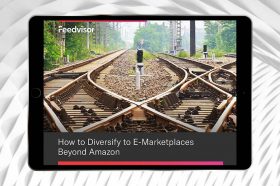Resources - Blog
Why CPG Brands Should Have an Amazon Strategy

Stay on top of the latest e-commerce and marketplace trends.
Food and beverage has been one of the slowest-moving categories to shift to online. Consumer packaged goods (CPG) companies have long depended on brick-and-mortar retailers to provide shelf space to get their products in front of shoppers, and those with a strong physical presence might feel they do not need an Amazon strategy, given that online sales make up just 2% of the overall food and beverage category, according to 2019 predictions from eMarketer.
Yet despite this small sales volume, food and beverage is the fastest-growing category on Amazon, up 40% in 2018, per eMarketer. More important, consumers are increasingly beginning their purchase journeys online, regardless of whether they ultimately make a purchase in-store. Two-thirds of consumers start their search for new products on Amazon, according to Feedvisor data, seeking everything from product details and price comparisons to customer reviews and brand credibility.
As such, solidifying an omnichannel presence is crucial to CPG growth, as further evidenced by Amazon’s acquisition of Whole Foods Market as well as the company’s reported plans of expanding its grocery footprint beyond Whole Foods stores. Just as Amazon realized its need to have a physical presence, CPG brands too must realize the importance of establishing a digital presence to maximize their reach, control their brand’s image and reputation, and drive incremental growth in both online and physical channels.
Why Amazon?
CPG brands that fail to keep pace with consumers’ digital trends risk losing the opportunity for a long-term competitive advantage as e-commerce inevitably continues to grow. Brick-and-mortar may be the norm today for food and beverage purchases, but in less than 10 years, online grocery shopping is expected to grow from 23% to as much as 70%, according to the Food Marketing Institute and Nielsen.
Plus, as the overwhelming majority of consumers agree that they are more likely to purchase products from Amazon than other e-commerce sites, per Feedvisor data, it is crucial that CPG brands ensure their products are properly represented on Amazon’s marketplace.
Getting started on Amazon may be overwhelming, but you should begin by taking ownership of your Amazon product detail page and optimizing it for search. Amazon is not only a channel where consumers shop but it is also where consumers go to browse. CPG companies should use Amazon as a brand-building marketing tool to attract new customers and convey how your brand and products differentiate from competitors.
Optimizing your product detail page with SEO-rich product descriptions will improve your organic search rank and offering clear, digestible details and concise information about your product’s differentiating benefits and features will help inform consumers’ buying decisions during the consideration phase.
When it comes to conveying product and brand information, Amazon boasts a clear advantage over brick-and-mortar channels. While brands are limited to the amount of in-store shelf space and product packaging to convey product details and brand attributes, an Amazon product details page offers endless digital space to convey your brand’s story and product information, further enhanced with images, videos, and customer feedback.
In addition, a majority of consumers agree that they trust the reviews on Amazon product listings, and social proof is becoming increasingly influential for consumers’ path to purchase. As you begin to develop your presence on Amazon, be sure to monitor your product reviews to keep up with consumer trends, customers’ concerns, and opportunities for product improvements.
Compete With National Brands
Amazon’s online grocery delivery platform, AmazonFresh, this year began allowing CPG brands to place Sponsored ads in search results. This is crucial as nearly half of consumers do not look beyond the second page of search results, according to Feedvisor data. By adding Sponsored ads to AmazonFresh, all CPG brands can promote their products within an AmazonFresh ASIN.
Ads for AmazonFresh can be targeted based on keywords and appear within Amazon’s regular search results and product details pages as well as within AmazonFresh-specific search results. However, you should note that these ads will only be visible to U.S. consumers who are eligible to shop AmazonFresh — which is only currently available in select cities like Los Angeles and New York City — though this also includes shoppers who are not AmazonFresh members.
This opportunity provides a particular advantage for smaller brands that often lose out to bigger brands for premium shelf space at brick-and-mortar channels. Niche and emerging products — which typically have less prominence in organic searches — can now compete with leading national brands for premium digital shelf space that will drive discoverability, conversions, and even growth in physical channels as a larger consumer base will gain visibility into your brand and product.
Final Thoughts
Online food and beverage sales may be small by volume, but the category is undoubtedly growing, and CPG brands that are slow to adapt risk a major disadvantage in the long-term. Having an established Amazon presence will allow CPG brands to control and maintain their brand’s messaging and reputation, understand the competitive digital environment, and drive visibility, as well as reveal opportunities to identify new target customers and improve the customer’s end-to-end experience.
Learn what Feedvisor can do for your business.
When you partner with Feedvisor, you automatically receive access to our true, AI-driven technology and hands-on team of e-commerce experts. Contact one of our team members today to learn more about our end-to-end solution for brands and large sellers on Amazon, Walmart, and e-marketplaces.




